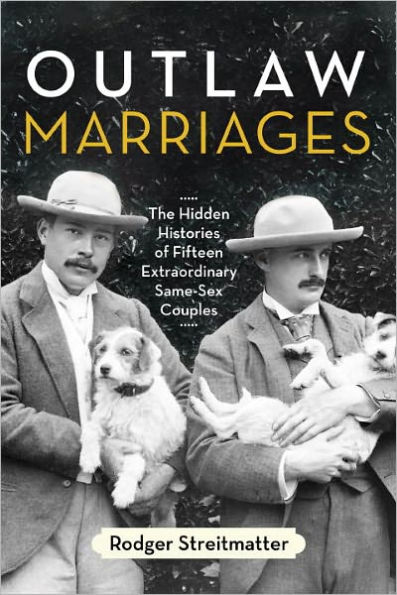Read an Excerpt
From the Prologue
The couples who come to life in the following chapters were social insurgents.
That is, each pair of men and each pair of women defied the social order by
creating sub-rosa same-sex marriages long before such relationships were
legally sanctioned.
Tennessee Williams and Frank Merlo, for example, began their outlaw
marriage in 1948—spending every day and night together, while loving and
supporting each other to a degree fully comparable to that of any husband
and wife. Their partnership continued until Merlo died of cancer in 1963.
Outlaw Marriages tells Williams and Merlo’s story, along with those of
fourteen other same-sex couples who combined their lives either as husband
and husband or wife and wife during eras when no legal institution and no
church approved of such a union.
The other trait that these renegade couples have in common is that they all
fully qualify as, in a word, extraordinary.
In many instances, that powerful adjective fits because of the remarkable
contributions a particular couple made to the culture—the fields ranging
from literature to modern art to filmmaking. The achievements of other couples
include opening graduate education to American women and pioneering
a new form of journalism in the pages of the New Yorker magazine.
With Williams and Merlo, their gift was creating some of the most memorable
plays in the history of American theater. Williams was addicted to
drugs and promiscuity when he met the rock-solid Merlo. The World War
II vet then saw to it that the playwright regained his emotional and physical
equilibrium, allowing him to write such theatrical masterpieces as the
Pulitzer Prize–winning Cat on a Hot Tin Roof.
A few of the other extraordinary contributions that unfold in this book are
• Walt Whitman and Peter Doyle reinventing American poetry
• Jane Addams and Mary Rozet Smith revolutionizing the field of social
work
• Greta Garbo and Mercedes de Acosta taking the lead in transforming
Hollywood into the celebrity capital of the world
When reading the statements above, you probably recognized only one of
the two names in the pairings. That’s because the achievements of one partner
often became widely known, while those of the other partner stayed
hidden—until the publication of this book.
Outlaw Marriages is an apt title on two levels.
First, all fifteen couples created unions that defied the laws and mores
of their day. Many of these de facto partnerships survived and thrived, despite
their lack of support by church or state, for thirty or forty years—in
some cases, fifty.
Second, these couples flouted convention. Aaron Copland was thirtytwo
years old when he met and instantly fell in love with a drop-dead gorgeous
violinist named Victor Kraft, who was only seventeen. The composer’s
friends and family didn’t take the relationship seriously, convinced the couple
wouldn’t survive the dramatic age difference. Copland and Kraft proved
them wrong. The men not only stayed together but also jointly created a distinctly
American style of music that critics today, eighty years later, are still
praising.
That the couples were willing to bend the marital rules doesn’t mean they
all succeeded in creating relationships that were made in heaven—far from
it. A regrettable scenario that plays out in several chapters begins with the
lesser-known partner being absolutely essential to the better-known partner’s
rise to success, but then . . . the high-achieving partner getting what might be
called the “twenty-year itch.” Martha Carey Thomas set the standard back in
the 1890s, summarily dumping her partner of two decades, Mamie Gwinn,
for another woman. Janet Flanner went a similar route in the 1930s, as did
Audre Lorde in the 1980s.
In the instances listed above as well as in others where the outlaw marriage
eventually falls apart, readers hear the whole story—which typically includes
infidelity, deceit, and betrayal. These unfortunate factors are revealed
in full detail, as they’re the realities that often confront any long-term relationship,
gay or straight.
To help the various outlaw marriages come alive in the reader’s mind,
I’ve included photos of all fifteen couples. Tracking down these images was
often a challenge, especially in the instances when one or both members of
a couple—as with Greta Garbo and Mercedes de Acosta—didn’t publicly acknowledge
their relationship. And so, in some cases, I’ve had to use two separate photos of the partners, since a single photo of them together either didn’t exist or wasn’t available. There are also instances—as with Jane Addams and Mary Rozet Smith—when I’ve used a photo of poor quality because it shows the partners together, even though higher-quality photos of the two individuals separately could have been used.
Whether a chapter begins with a single image or a pair of them, each story
that follows is a page-turner. Sometimes the most compelling element in it is
the contribution the couple made; other times, it’s the internal dynamics of
their relationship. But one theme runs through them all:
Two people joining together to create an outlaw marriage plays a central
role not only in the couple’s extraordinary achievements, but also in each individual
partner’s very being.



